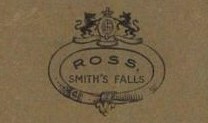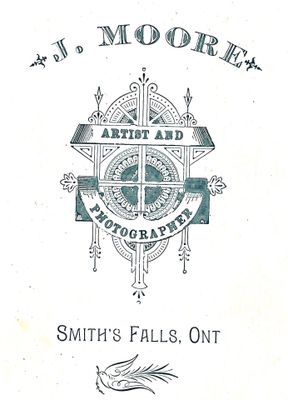
Pictures of Every Description Taken in the Best Style of the Art: Smiths Falls photographers ca.1880-1925
Introduction
Panels
IntroductionJohn Moore, gallery 1John Moore, gallery 2John Moore, gallery 3, a family albumJ.J. Kerfoot, gallery 1J.J. Kerfoot, gallery 2J.J. Kerfoot, gallery 3J.J. Kerfoot, gallery 4Hugh RossEva BriggsD. Hayes, S. Kirkfoot, J. Milliken, D. Stone, John Joynt, Frederick and Edwin Crane, and J. Bradley
J.J. Kerfoot stamp, Smiths Falls, exhibit record Details

Briggs directory listing, Smiths Falls Details

Hugh Ross stamp, 1912, Smiths Falls, exhibit record Details

Moore Studio, Smiths Falls Details
Rapid advances in photographic technology in the late 19th century changed the marketplace for both photographers and the public. Photographers in towns and cities could now charge a studio session for a reasonable price and the public was eager. Many people welcomed this opportunity to have a high-quality image of themselves, their families or friends at a special moment in their lives. Demand for their services grew to such an extent that local full-time photographers earned a living in many towns. Some photographers, however, opened studios but were short-lived in their endeavours, perhaps due to market saturation. Still other photographers travelled to small towns and villages for short periods of time to offer their specialized services. They stayed in hotels which often also served as temporary studios. The books The Ontario Photographers List (1851-1900) and The Ontario Photographers List Volume II (1901-1925) contain the names of a number of photographers who worked in Smiths Falls between 1865 and 1925, including John Moore, J. J. Kerfoot, Hugh Ross and Eva Briggs whose works are presented in this exhibit. John Moore's work is well represented here while the work of Eva Briggs is currently limited to one image.We know that there were four photographic studios operating in Smiths Falls in 1896 - The Rideau Record described the impact of a recent punishing hailstorm, noting that "The four photograph galleries all suffered severely, the entire skylights of some of them collapsing altogether." One of these damaged galleries was owned by John Moore who opened his studio in 1878. The second studio might have been that of Eva F. Briggs who began working in 1891. The owners of the two other photographic studios who experienced that July hailstorm are presently unknown. At the turn of the 20th century, Smiths Falls residents had two new photographers from which to chose. J.J. Kerfoot first practiced photography while working at Moore's studio and then later established his own solo career circa 1900 to 1927. Hugh A. Ross also ran a successful photography studio between 1901 and 1925. Studio portraits allowed both photographer and subject to create and perfect a desired image. The controlled setting of a studio negated potentially troublesome matters such as weather and unintended interruptions. Studio settings also permitted people to select a plain backdrop, a painted scene or props such as a particular style of chair. Photographers also offerred customers a variety of decorative mounts to enhance the display of their photos.Please note that the size of image presented here varies considerably due to the size of the original file source.
